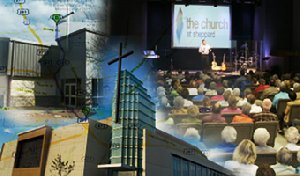The term “multisite” or “multicampus” church might first bring megachurches to mind.
But as it has developed, the church-growth model has taken on many forms to serve a variety of purposes and ministry contexts.
 |
Ministry
Some churches use the multicampus model as a way to meet specific needs.
Broadview Baptist Church in Abilene set up a second site in a trailer park of highly mobile, lower-income families. “We knew it wouldn’t ever be able to be self-supporting,” Pastor David Cason explained.
The church changed its strategy in 2005, when members became convinced God was calling them to reach out to the socio-economically disadvantaged in the city.
The second site has been able to break down barriers of ethnicity and economics much more than members would have been able to do at the main campus, Cason said.
Culture
Some churches choose the multisite option to reach a wide range of cultures or subcultures. Some of those target language and international cultural groups.
Bon Air Baptist Church in Richmond, Va., has four campuses. One grew out of a previous ministry in a mobile home park combined with a group of about 10 to 15 Hispanics meeting in a room at the church’s oldest campus on Buford Road. The combined ministry now meets in a storefront and offers two worship services, one in Spanish and one in English, with two site pastors—one Hispanic and one Anglo.
All Souls Church in Charlottesville, Va., started as a house church in 2009 and now includes what it calls “small communities,” each embedded contextually among the people it serves. The church sees its context as broadly including “all sorts of people” but particularly drawn to a subculture of “cultural creatives”—people who are artistic, progressive, socially conscious and spiritually open. The church has several small communities scattered throughout the city.
Lifestyle
Some people want to stay close to their neighborhood for much of their activity outside of career responsibilities. One Bon Air site targets people within a five-mile radius who use the nearby bypass to get to their offices. Otherwise, most don’t like to drive out of their area.
Pleasant Valley Baptist Church in Liberty, Mo., also targets people not already connected to the church who do not like to drive any distance to worship. The congregation started a second campus near Kansas City International Airport to help church members reach friends and relatives in that area who would not drive out to the main campus.
Sustain growth
One reason multisite churches often are synonymous with megachurches is size. Tom Cheyney of the Southern Baptist Convention’s North American Mission Board and co-author of Sponsoring Starbucks’ Churches in a Folgers World, suggests space considerations should be the primary reason for opening a second or third campus.
“Whether you are an existing church or a new church plant, the real reason behind considering such an approach should be due to lack of space,” he wrote in “The Multisite Church Planting Strategy: Possibly the Most Effective Channel for ‘Doing Church’ in the 21st Century,” an article posted on NAMB’s church planting network website, churchplantingvillage.net.
He sees the multicampus approach as a movement to sustain continued growth of a particular congregation. “When the church moves away from its four-walled expression, it will discover the tremendous power of reproduction,” he wrote.
“Usually, by moving strategically into other sites, it allows the corporate church as a whole to continue to grow while adding other meeting sites. These sites allow for further growth without adding the significant cost of building a new facility.”
Forms
The multicampus model takes on various forms depending upon the needs of the churches that adopt it. Conjoined congregations are multisites that meet simultaneously, sharing the same preacher and worship experience from one live site with a video or Skype link.
Some churches share the senior pastor through video playback, sometimes by taping an early service on the main campus and sending it to other sites or by using the taped version the following week.
Some use a hybrid approach, with the same sermon but different songs or with a different sermon and different songs from the main campus.
Some share the same senior pastor for all ministry needs among all campuses, while others share a senior pastor but have a campus pastor for each site.
